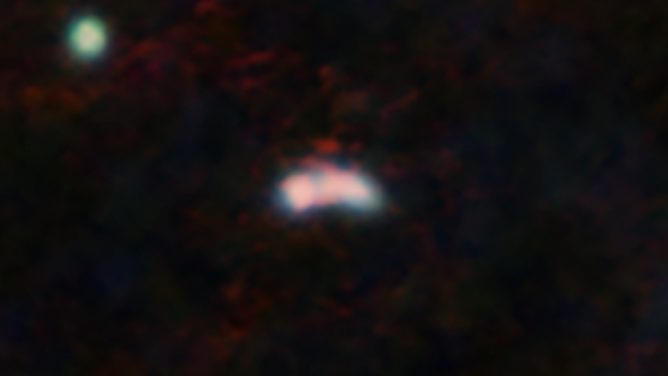2019.08.08
ALMA Identified Dark Ancestors of Massive Elliptical Galaxies - Unexpected Hidden Galaxies Question Theories of Universe Evolution

ALMA identified 39 faint galaxies that are not seen with the Hubble Space Telescope’s deepest view of the Universe 10 billion light-years away. This example image shows a comparison of Hubble and ALMA observations. The squares numbered from 1 to 4 are the locations of faint galaxies unseen in the Hubble image.
Credit: The University of Tokyo/CEA/NAOJ

Artist’s impression of the distant galaxies observed with ALMA. ALMA identified faint galaxies invisible to the Hubble Space Telescope. Researchers assume that those HST-dark galaxies are the ancestors of massive elliptical galaxies in the present Universe.
Credit: NAOJ
“Previous studies have found extremely active star-forming galaxies in the early Universe, but their population is quite limited,” says Tao Wang, the lead author of the paper and a researcher at the University of Tokyo, French Alternative Energies and Atomic Energy Commission (CEA), and the National Astronomical Observatory of Japan. “Star formation in the dark galaxies we identified is less intense, but they are 100 times more abundant than the extreme starbursts. It is important to study such a major component of the history of the Universe to comprehend galaxy formation.”
Wang and his team targeted three ALMA windows to the deep Universe opened up by the Hubble Space Telescope (HST): the CANDELS fields. The team discovered 63 extremely red objects in the infrared images taken by NASA’s Spitzer Space Telescope: they are too red to be detected with HST. However, Spitzer’s limited spatial resolution prevented astronomers from identifying their nature.
ALMA detected submillimeter-wave emission from 39 out of the 63 extremely red objects. Thanks to its high resolution and sensitivity, ALMA confirmed that they are massive, star-forming galaxies that are producing stars 100 times more efficiently than the Milky Way. These galaxies are representative of the majority of massive galaxies in the Universe 10 billion years ago, most of which have so far been missed by previous studies.
“By maintaining this rate of star formation, these ALMA-detected galaxies will likely transform into the first population of massive elliptical galaxies formed in the early Universe,” says David Elbaz, an astronomer at CEA, and coauthor on the paper, “But there is a problem. They are unexpectedly abundant.” The researchers estimated their number density to be equivalent to 530 objects in a square degree in the sky. This number density well exceeds predictions from current theoretical models and computer simulations. In addition, according to the widely accepted model of the Universe with a certain type of dark matter, it is difficult to build a large number of massive objects in such an early phase of the Universe. Together, the present ALMA results challenge our current understanding of the evolution of the Universe.
“Like the galaxy M87, in which recently astronomers obtained the first-ever image of the black hole, massive elliptical galaxies are located in the heart of galaxy clusters, which are believed to form most of their stars in the early Universe. ” explains Kotaro Kohno, a professor at the University of Tokyo and member of the research team. “However, previous searches for the progenitors of these massive galaxies have been unsuccessful because they were based solely on galaxies that are easily detectable by HST. The discovery of this large number of massive, HST-dark galaxies provides direct evidence for the early assembly of massive galaxies during the first Gyr of the Universe.” More detailed follow-up observations with ALMA and NASA’s James Webb Space Telescope will be essential to provide further insights into the nature of these galaxies, enabling a complete view of galaxy formation in the early Universe.”
Paper and the Research Team
These observation results are published as T. Wang et al. “A dominant population of optically invisible massive galaxies in the early Universe” in Nature on August 7, 2019.
The research team members are:
T. Wang (The University of Tokyo/CEA/National Astronomical Observatory of Japan), C. Schreiber (CEA/Leiden University/Oxford University), D. Elbaz (CEA), Y. Yoshimura (The University of Tokyo), K. Kohno (The University of Tokyo), X. Shu (Anhui Normal University), Y. Yamaguchi (The University of Tokyo), M. Pannella (Ludwig-Maximilians-Universitat,), M. Franco (CEA), J. Huang (National Astronomical Observatories of China), C.-F. Lim (Academia Sinica Institute of Astronomy and Astrophysics), and W.-H. Wang (Academia Sinica Institute of Astronomy and Astrophysics)
This research was supported by NAOJ ALMA Scientific Research Grant Number 2017-06B, JSPS KAKENHI (No. JP17H06130), funding from the European Union Seventh Framework Program (FP7/2007-2013) under grant agreement No. 312725 (ASTRODEEP), NSFC 11573001, National Basic Research Program 2015CB857005, and Ministry of Science and Technology of Taiwan Grant (105-2112-M-001-029-MY3).









